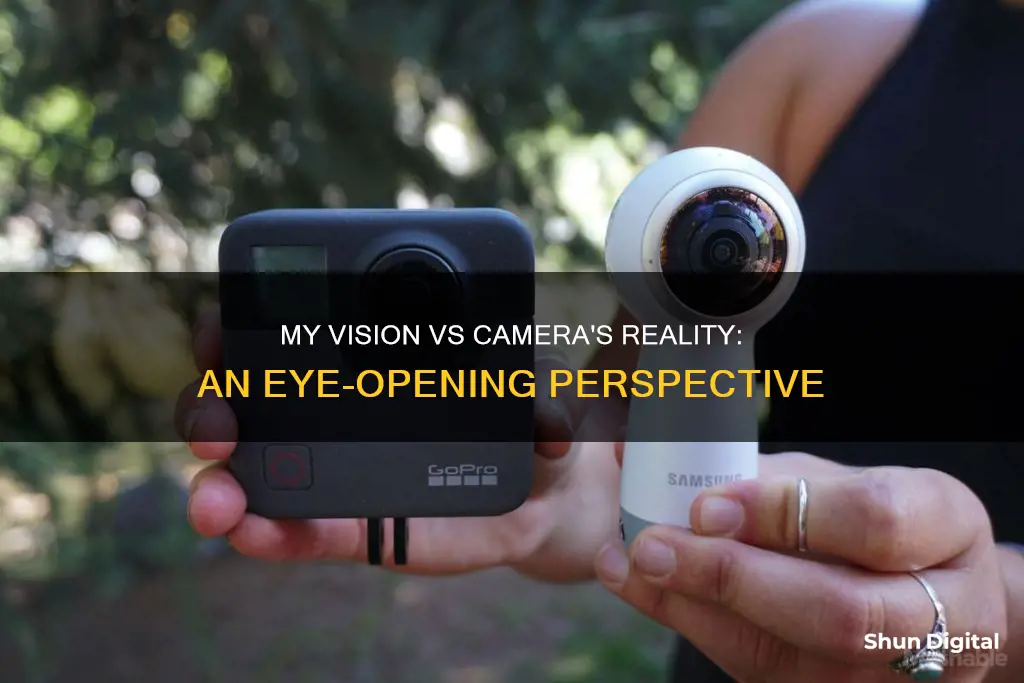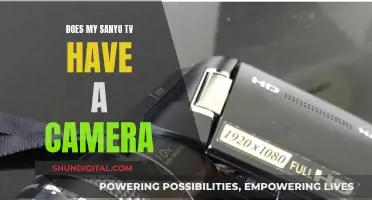
The human eye and the camera lens often capture very different images of the same scene. While the human eye can dynamically adjust to a wide range of lighting conditions and focus on a variety of objects, a camera often requires manual adjustments to capture the desired image. This comparison is an interesting topic to explore, as it highlights the differences in how humans and cameras perceive the world.
What You'll Learn

Camera angles and perspective
Zooming
Zooming gives the impression of moving closer to or further away from the subject. While it can effectively magnify a focus point, other techniques like dolly shots provide a more natural way to show movement. A quick zoom can add drama and energy, but it's important not to over-use it.
Panning
Panning involves moving the camera horizontally from one side to another while keeping its position fixed. It can be used to follow a character or capture a landscape, creating a sense of place. Panning is practical for guiding the viewer's attention and is useful in action sequences to maintain focus on a moving subject.
Tilting
Tilting is similar to panning but focuses on upward and downward movements, allowing more to be fit into a single frame. A slow upward tilt can make a subject appear bigger or more significant, while a downward tilt has the opposite effect.
Dolly Shots
In a dolly shot, the camera is mounted on a track and moved toward or away from the subject. This creates the illusion of the viewer walking toward the subject and can be used to establish intimacy. The dynamic transitions make the audience feel part of the scene and help establish a connection between characters and their surroundings.
Trucking
Trucking is similar to dollying but involves moving the camera from side to side rather than in and out. It is often used to follow characters in action and reveal elements of the environment gradually. Trucking can shift the audience's attention, build empathy, and simulate a character's perspective, allowing the viewer to 'walk' beside them.
Pedestal Shots
A pedestal shot requires the camera operator to move the camera vertically upward or downward in relation to the subject, adjusting the viewer's perspective within the scene. This technique can be used to frame tall subjects while maintaining an eye-level view for the viewer. It adds dynamism and reveals new details, especially in environments with significant vertical elements like cityscapes.
Establishing Shots
Establishing shots, typically long and wide, are often used at the beginning of a scene to build ambiance and provide context. They set the tone, enhance engagement, and offer a spatial understanding of the character's environment and their physical actions.
Full Shots
Full shots show the entire body of the subject, emphasising their physical presence, movements, and body language. They provide a comprehensive view of the character within their surroundings, helping the audience grasp the character's physical actions and interactions.
Medium Shots
Also known as 3/4 shots, medium shots show the subject from the knees up, allowing the viewer to see both their gestures and the background environment. This strikes a balance between intimacy and context, capturing the character's physical actions and emotional nuances.
Close-Up Shots
Close-up shots focus on the subject's head or face, thrusting them into the forefront and making their reactions and emotions the centre of attention. This creates a deep sense of connection between the viewer and the subject, intensifying their emotional engagement and empathy.
Extreme Close-Up Shots
In extreme close-up shots, the camera is so close that only a specific detail, like the eyes or mouth, is visible. This unconventional technique should be used sparingly but can infuse scenes with heightened tension, emotion, and significance when used appropriately.
Low and High Angle Shots
Low angle or up shots are taken from below the eye level of the subject, creating a perception of power, heroism, or danger. In contrast, high angle or down shots evoke vulnerability, powerlessness, or insignificance. These angles can be used to create empathy or pity for a character, especially in tense or compromising situations.
Over-the-Shoulder Shots
Over-the-shoulder shots are common in filmmaking and photography, positioning the camera behind one character's shoulder while framing the subject in a close or medium shot. This effectively captures interactions between characters, allowing viewers to connect verbal communication with non-verbal cues and emotional responses.
Two Shots
Two shots present two characters sharing the frame, often side by side or in close proximity. This introduces their connection and conveys information about their relationship and dynamics without relying solely on dialogue. The positioning of the characters can imply equality, power imbalances, or hierarchical relationships.
The Evolution of Smartwatch Cameras: Where Are They Now?
You may want to see also

Lighting and exposure
The human eye is an incredible instrument, with an impressive dynamic range that can adapt to a variety of lighting conditions. Our eyes can see in dimly lit rooms and still appreciate details in bright highlights. However, cameras often struggle to capture this wide range of lighting conditions in a single image, resulting in underexposed or overexposed areas.
One of the key differences between what we see and what our cameras see is the dynamic range of lighting. Our eyes can perceive a wide range of brightness levels, from the faint glow of stars on a moonless night to the dazzling brilliance of sunlight. Cameras, on the other hand, have a more limited dynamic range, which means they often fail to capture the full range of light and shadow present in a scene.
To compensate for this, photographers use techniques such as exposure bracketing, where multiple images are captured at different exposure settings and then combined to create a high dynamic range (HDR) image. This allows for a more accurate representation of the lighting conditions as perceived by the human eye.
Another factor to consider is the colour temperature of the light. Our eyes are adept at adjusting to different lighting conditions, such as the warm glow of incandescent bulbs or the cool, bluish light of the shade, and we can still perceive colours accurately. Cameras, however, need to be adjusted to compensate for different colour temperatures to avoid colour casts that affect the overall exposure of an image.
Additionally, the direction and quality of light play a significant role in photography. Photographers often seek out the "golden hour," the hour just after sunrise or before sunset, when the light is soft, warm, and flattering. During this time, the light is more diffused and indirect, reducing harsh shadows and creating a pleasing, even exposure.
In conclusion, while our eyes are remarkable instruments that can adapt to a wide array of lighting conditions, cameras require more careful consideration and adjustment to capture the full essence of a scene. Understanding the limitations of cameras and employing techniques to overcome them can help photographers create images that more closely resemble the lighting and exposure perceived by the human eye.
TV Cameras: Are They Watching You?
You may want to see also

Colour accuracy
The human eye and the camera lens have different ways of perceiving and capturing colour. The eye sees colours as part of a scene, with the brain interpreting the light and context to provide a full and accurate image. A camera, on the other hand, captures colours as individual entities, and the colours are then reproduced as a combination of these captured hues.
The eye is incredibly sensitive to colour, and can perceive millions of distinct shades. This is due to the complex nature of the eye's photoreceptors, which include rods and cones that detect light and colour. The eye's lens also adjusts to the amount of light available, ensuring optimal colour perception in various lighting conditions. In low light, for example, the pupil widens to let in more light, allowing the eye to continue to see colours accurately.
Cameras, however, cannot replicate this level of colour accuracy. While modern cameras are advanced, they cannot match the complexity of the human eye. They use a combination of red, green, and blue sensors to capture colour information, and the accuracy of this data depends on the lighting conditions and the camera's settings. Cameras can struggle with certain colours, such as very light or dark shades, and may not accurately reproduce them.
The white balance setting on a camera is designed to help with colour accuracy. This setting adjusts the camera's sensors to correctly interpret the colour white, which is used as a reference point for all other colours in the image. By correctly setting the white balance, the camera can more accurately capture the full spectrum of colours in a scene.
Despite these advances, cameras still cannot match the human eye's ability to perceive colour in all its nuances. The eye and brain work together to provide an instantaneous and complete understanding of a scene's colours, including their context and relationships to one another. Cameras capture colours in a more mechanical way, and while the results can be impressive, they often require additional editing to achieve a true-to-life colour representation.
Capturing Glow-in-the-Dark: Camera Tricks for Amazing Photos
You may want to see also

Focus and depth of field
The depth of field (DoF) is the zone within a photo that appears acceptably sharp and in focus. It is the distance between the nearest and the farthest objects that are in acceptably sharp focus in an image. The size of this zone of sharpness will vary from photo to photo depending on different factors, such as the lens's aperture setting, the focal length of the lens, and the distance between the lens and the subject.
Aperture size, or f-stop, is the opening at the rear of the lens that lets light travel through the lens and fall on the image sensor. The size of the aperture is measured in f-stops, with smaller f-numbers corresponding to wider apertures and shallower depths of field, and larger f-numbers corresponding to narrower apertures and deeper depths of field. For example, a shallow depth of field can be achieved with an f-stop of f/2.8, while a deep depth of field can be achieved with an f-stop of f/11 or higher.
The distance between the lens and the subject also affects the depth of field. The closer the subject is to the lens, the shallower the depth of field becomes. Conversely, the farther away the subject is, the deeper the depth of field. However, changing the distance to the subject can also change the image's composition, so it is not always a practical way to manipulate the depth of field.
The focal length of the lens also plays a role in determining the depth of field. Longer lenses tend to produce shallower depths of field, while shorter lenses produce deeper depths of field. This is because the visual properties of a given lens affect the depth of field, with shorter focal lengths resulting in deeper depths of field than longer focal lengths when all other factors are equal.
By adjusting these three factors—aperture size, distance to the subject, and focal length—photographers can control the depth of field in their images, creating either a shallow or deep depth of field as desired.
Self-Driving Cars: What Do Their Cameras Actually See?
You may want to see also

Composition and framing
When it comes to composition and framing, there are several key differences between what you see with your eyes and what your camera captures. These variations arise due to the unique capabilities and limitations of both our visual perception and camera equipment. Here are some essential considerations:
Firstly, our field of view is much wider than that of most cameras. Our peripheral vision allows us to take in a broader scene, which can be advantageous when composing a photograph. When framing a shot, it's important to be mindful of this disparity and ensure that the elements within the camera's field of view are carefully arranged to convey the desired narrative or emotion. This often involves paying close attention to the background, foreground, and the placement of subjects within the frame.
Secondly, the dynamic range of our vision is far superior to that of a camera. Our eyes can perceive details in both bright highlights and dark shadows simultaneously. Cameras, on the other hand, often struggle to capture the full range of light and darkness present in a scene. This limitation can result in overexposed highlights or underexposed shadows in photographs. To mitigate this, photographers often use techniques such as exposure bracketing or HDR (High Dynamic Range) imaging to capture a more accurate representation of the light and darkness present in the scene.
Another critical aspect is depth of field. Our eyes have an incredible ability to adjust focus seamlessly, allowing us to perceive depth and sharpness across a wide range of distances. In contrast, cameras have a more limited depth of field, which means that only a specific portion of the image may be in focus while the rest appears blurry. Photographers can use this depth of field creatively to draw attention to certain elements within the frame or to blur the background and foreground for a more artistic effect.
The use of lines and shapes to create leading lines or form a pleasing composition is another essential consideration. Our eyes are naturally drawn to patterns, symmetry, and balance within a scene. By incorporating leading lines or framing the subject using natural or architectural shapes, photographers can create visually appealing images that guide the viewer's gaze toward the main subject. Leading lines can be formed by roads, rivers, fences, or any other linear element within the scene.
Lastly, while our eyes perceive the world in three dimensions, cameras capture it in two. This means that the sense of depth and perspective in a photograph is created through the arrangement of two-dimensional elements within the frame. Photographers can employ techniques such as the rule of thirds or the use of foreground elements to suggest depth and lead the viewer's eye into the image. Additionally, the choice of lens and perspective can greatly impact the perceived depth and size of objects in the final image.
The Man With a Movie Camera: Where to Watch
You may want to see also







